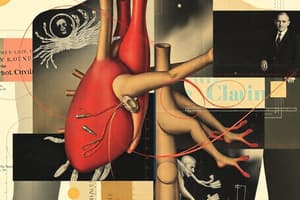Podcast
Questions and Answers
Which type of cholinergic agonist directly binds to cholinergic receptors?
Which type of cholinergic agonist directly binds to cholinergic receptors?
- Direct-acting cholinergic agonists (correct)
- Indirect-acting cholinergic agonists
- Anticholinergic drugs
- Adrenergic agonists
What is the primary mechanism of action of indirect-acting cholinergic agonists?
What is the primary mechanism of action of indirect-acting cholinergic agonists?
- Increasing acetylcholine breakdown
- Activating adrenergic receptors
- Blocking the breakdown of acetylcholine (correct)
- Direct binding to cholinergic receptors
Which of the following is NOT a direct-acting cholinergic agonist?
Which of the following is NOT a direct-acting cholinergic agonist?
- Physostigmine (correct)
- Pilocarpine
- Neostigmine
- Acetylcholine
Which condition can be managed using direct-acting cholinergic agonists?
Which condition can be managed using direct-acting cholinergic agonists?
What effect do cholinergic agonists typically have on the parasympathetic nervous system?
What effect do cholinergic agonists typically have on the parasympathetic nervous system?
How do indirect-acting cholinergic agonists differ from anticholinergic drugs?
How do indirect-acting cholinergic agonists differ from anticholinergic drugs?
Which of the following best describes the mechanism of action of cholinergic agonists?
Which of the following best describes the mechanism of action of cholinergic agonists?
In which condition are cholinergic agonists commonly used as a prophylaxis for abnormal bleeding?
In which condition are cholinergic agonists commonly used as a prophylaxis for abnormal bleeding?
Which of the following is NOT a common side effect of cholinergic agonists?
Which of the following is NOT a common side effect of cholinergic agonists?
How do anticholinergic drugs differ from cholinergic agonists in terms of their mechanism of action?
How do anticholinergic drugs differ from cholinergic agonists in terms of their mechanism of action?
Which neurological disorder is commonly treated with cholinesterase inhibitors like donepezil and rivastigmine?
Which neurological disorder is commonly treated with cholinesterase inhibitors like donepezil and rivastigmine?
Why are cholinergic agonists used in eye drops instead of topical alpha adrenergic agonists?
Why are cholinergic agonists used in eye drops instead of topical alpha adrenergic agonists?
Flashcards are hidden until you start studying
Study Notes
Cholinergic Agonists: Mechanism of Action, Therapeutic Uses, Side Effects, Types, Comparison with Anticholinergic Drugs
Cholinergic agonists are a class of drugs that mimic the action of the neurotransmitter acetylcholine, which plays a crucial role in the parasympathetic nervous system (PNS). These drugs bind to and activate receptors, either directly or indirectly, to increase the availability of acetylcholine at the target site. There are two main types of cholinergic agonists: direct-acting and indirect-acting.
Direct-Acting Cholinergic Agonists
Direct-acting cholinergic agonists directly bind to cholinergic receptors, particularly those of the muscarinic type. Common examples include choline esters like acetylcholine itself, as well as synthetic compounds such as pilocarpine and cevimeline. Direct-acting cholinergic agonists are used for various purposes, such as managing conditions like myasthenia gravis through anticholinesterase agents like pyridostigmine.
Indirect-Acting Cholinergic Agonists
Indirect-acting cholinergic agonists increase the availability of acetylcholine at the cholinergic receptors by blocking the breakdown of endogenous acetylcholine. This group includes reversible agents like physostigmine, neostigmine, and irreversible agents such as echothiophate or parathion. Indirect-acting cholinergic agonists are typically used in cases where there is impaired acetylcholine production or utilization, such as in certain ophthalmic conditions or in the context of neuromuscular blockers.
Therapeutic Uses
Cholinergic agonists serve a variety of therapeutic roles. For instance, they are used in treating neurological disorders like Alzheimer's disease, Parkinson's disease, and schizophrenia through cholinesterase inhibitors like donepezil, galantamine, and rivastigmine. Additionally, cholinergic agonists find application in eye drops to dilate pupils (chosen for their longer duration of action compared to topical alpha adrenergic agonists) and as a prophylaxis in abnormal bleeding due to heparin (ECMO circuit perfusion) due to reduced bleeding rates and high efficiency in reducing platelet activation.
Side Effects
Despite their useful therapeutic qualities, cholinergic agonists can cause a range of side effects. These may include bone marrow suppression, sore throat, blurred vision, increased sweating and salivation, increased urinary frequency, rash, fever, dry mouth, gastric irritation, flushing, abnormal liver function tests, palpitation, irregular heart rate, dryness and scaling of the skin, nausea, diarrhea, abdominal cramping, low blood pressure, and more.
Comparison with Anticholingeric Drugs
While cholinergic agonists stimulate cholinergic receptors, anticholinergic drugs act by blocking these receptors, thus producing opposite effects on the body. Anticholingeric drugs have been explored for potential therapeutic benefits related to the regulation of the cholinergic system, such as their ability to potentially suppress tumor cell proliferation through the inhibition of M3 receptor activation. However, both cholinergic agonists and anticholinergic drugs share a risk of causing side effects, which must be carefully managed and monitored.
Studying That Suits You
Use AI to generate personalized quizzes and flashcards to suit your learning preferences.





